Martin Edwards's Blog, page 215
October 10, 2013
Italy and Crime Fiction

Like so many lovely places, Italy is a popular setting for crime stories, and I suppose the leading exponent of Italian detective fiction currently known to British readers is Andrea Camilleri, creator of Inspector Montalbano. As the years pass, I draw some comfort from the fact that he did not create his most successful character until he was nearly 70! Like Ellis Peters, he achieved international fame late in life,but it is well deserved. Camilleri comes from Sicily, a gorgeous island I've enjoyed visiting twice, but during my recent holiday I concentrated on exploring the north of the country, and spent a day with Italian friends in Florence.



Florence is the setting for the books by the late Magdalen Nabb, possibly my favourite British author of crime novels set in Italy.The fabulous Duomo also earns a thought-provoking mention in Harlan Coben's Stay Close, which I'm reading in the moment, though that book is firmly set in the US. Flroentine daggers were popular murder weapons during the Golden Age in particular, but I resisted any temptation to invest in one of my own whilst I was in the city.
My visit reminded me that it's a long time since I read any of the Zen novels by the late Michael Dibdin. One I never read was Back to Bologna, but that's now zoomed up the to-read list. I can't recall if he set any of his stories in any of the smaller, but quite breathfaking, places within easy reach of Bologna. Modena, for instance, is famous for its cathedral, and I was also struck by the nearby 'haranguing stone', an elevated slab in the piazza on which wrongdoers were placed to face public opprobrium.



Ferrara is, to my mind, even more impressive, with its terrific moated castle,grassed ramparts and a host of wonderful sights. As I was walking round, the idea for one of the two short stories I mentioned in my blog post yesterday came to mind.



Finally, Ravenna. It's famous for its mosaics, and these really are dazzling. The old mausoleum and the archaeological museum, with its ivory throne, are among countless sights packed in to a small area, easily walkable. You can also find Dante;'s grave and an interesting exhibition, which gave me a much better understanding of his work (perhaps I should read Dan Brown's Inferno too?) Dorothy L. Sayers translated and admired Dante, but I don't know if she ever visited Ravenna. If so, I'm sure she was impressed. Like Ferrara, it would make a terrific setting for a detective novel, and I'm sure that some writers have already made good use of it. I look forward to tracking down one or two examples.

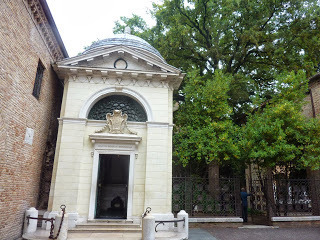


Published on October 10, 2013 03:29
October 9, 2013
Back from Bologna


 Italy is the setting for a great many fine crime novels and also, without question, one of my favourite countries in the world. So I thoroughly enjoyed spending a week in north Italy, based in Bologna, but venturing out to some of the historic and beautiful towns in the area. Bologna itself is a vibrant city with an ancient university and plenty of fascinating places to visit, including its very own leaning tower, as well as plenty of street performers, open air concerts and so on.
Italy is the setting for a great many fine crime novels and also, without question, one of my favourite countries in the world. So I thoroughly enjoyed spending a week in north Italy, based in Bologna, but venturing out to some of the historic and beautiful towns in the area. Bologna itself is a vibrant city with an ancient university and plenty of fascinating places to visit, including its very own leaning tower, as well as plenty of street performers, open air concerts and so on.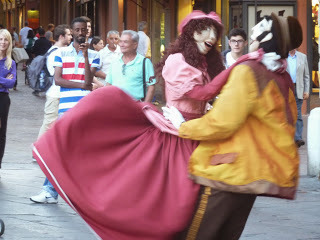

You could spend a lot longer than a few days there, just marvelling at the history and architecture as well as the culture, the often hidden canals, and of course the food.In terms of sightseeing, first stop was the impressive library in the Piazza Maggiore. It's unique in that you can also visit the ancient Roman ruins and the old town that lie beneath the building, some of which can be seen through panels in the floor at ground level. And then it was on to the Whispering Gallery, Eataly (a combination of bookshop and restaurant that stocked loads of Golden Age classics and served very good food) and the amazing Teatro Anatomica, where public dissections used to take place. Spot the dissecting table in the photo!

The Basilica of San Luca stands just outside the old city walls, at the top of a hill that can be reached via a walkway with 666 arches - a very stiff climb in searing heat, and I confess I opted for the little train that wove through the city streets before tackling the hill. The result was spectacular views, enjoyed without being exhausted. Just as well, since there was lot of walking to be done, both in Bologna and in the other towns within easy reach by train.




Despite Italy's economic problems, Bologna seems a pretty affluent place and I was pleasantly surprised by the number of bookshops, even by the standards of university cities (incidentally, there were also loads of bookshops in Budapest, but my Hungarian is even worse than my Italian!). Reading does seem to be enormously popular in Italy and tomorrow I'll say a bit more about Italian crime fiction. I did manage to get some reading done, mainly on the plane and train trips, but the real focus was on discovering a part of the world that seems to me to have enormous appeal. I'm also pleased to say that Bologna gave me two brand new ideas for short stories, though with my current schedule, I'm not quite sure when I'll get round to writing them.



Finally, a special word of thanks to the Bologna tour guide, namely Catherine Edwards, a linguist who is dividing her year abroad between Bologna, Rome and Berlin, lucky thing. An aspiring journalist who has already worked on a number of publications, including The Big Issue, for which she reviewed Harlan Coben's latest, and she has just started her own blog, From Bologna to Berlin. Biased as perhaps I am, I think makes very interesting reading and it will be featuring on the blogroll shortly.
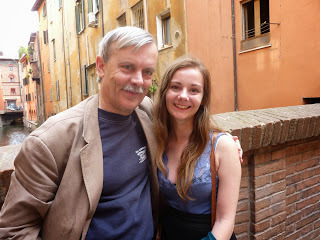
Published on October 09, 2013 07:18
October 7, 2013
Ellis Peters and Wellington Literary Festival
This year sees the centenary of the birth of Edith Pargeter, better known to crime lovers as Ellis Peters, the creator of Brother Cadfael. Although she often travelled abroad, set many books overseas, and was a noted translator of works written in Czech, she was first and foremost a woman of Shropshire, the county where she was born and spent nearly all her life, and which featured in many of her best books. Pleasingly, Wellington Town Council in Shropshire decided to celebrate her at its Literary Festival this year and I was honoured to be asked to be the guest speaker, discussing her life and work.
I imagine the invitation stemmed in part from the fact that I edited a collection of obscure Peters stories for a book published by Crippen and Landru some years ago, The Trinity Cat, and in part from the fact that I've written about her work on a few occasions, for instance in Following the Detectives, edited by Maxim Jakubowski. So I was glad to accept, although as I journeyed down the M6 to Wellington through ghastly traffic, I reflected that travel hasn't improved as much as it should since Cadfael journeyed around in the twelfth century.
One thing that impressed me enormously was the venue for the Festival. This is a large and recently built leisure centre which includes a public library, and much else besides. The very pleasant town councillor who introduced my talk was clearly proud of the centre, and quite right too. This is exactly the sort of project that provides tremendous benefits to a community, and my impression was that the facilities are well used and much appreciated.
Putting a library together with other leisure resources may sometimes be complicated and far from cheap, but the social dividends can be hugely rewarding if it is done well (in a more modest way, it's been done in my home village,Lymm, and again the results have been admirable.) In the 21st century, when maintaining social cohesion is, in many ways, as important as ever it has been, a high calibre venue such as this brings people together and ensures that events like the Literary Festival are not only possible but likely to be successful and greatly valued.
The festival committee had certainly done a good job in getting an eclectic list of speakers: it's not often that Germaine Greer and I are metaphorically rubbing shoulders in the same programme. Although I've visited nearby Ironbridge before, I 'd never stopped in Wellington previously, but I was really struck by what the local people, and their authority, have created. And I'm sure Edith Pargeter would have been impressed as well.
I imagine the invitation stemmed in part from the fact that I edited a collection of obscure Peters stories for a book published by Crippen and Landru some years ago, The Trinity Cat, and in part from the fact that I've written about her work on a few occasions, for instance in Following the Detectives, edited by Maxim Jakubowski. So I was glad to accept, although as I journeyed down the M6 to Wellington through ghastly traffic, I reflected that travel hasn't improved as much as it should since Cadfael journeyed around in the twelfth century.
One thing that impressed me enormously was the venue for the Festival. This is a large and recently built leisure centre which includes a public library, and much else besides. The very pleasant town councillor who introduced my talk was clearly proud of the centre, and quite right too. This is exactly the sort of project that provides tremendous benefits to a community, and my impression was that the facilities are well used and much appreciated.
Putting a library together with other leisure resources may sometimes be complicated and far from cheap, but the social dividends can be hugely rewarding if it is done well (in a more modest way, it's been done in my home village,Lymm, and again the results have been admirable.) In the 21st century, when maintaining social cohesion is, in many ways, as important as ever it has been, a high calibre venue such as this brings people together and ensures that events like the Literary Festival are not only possible but likely to be successful and greatly valued.
The festival committee had certainly done a good job in getting an eclectic list of speakers: it's not often that Germaine Greer and I are metaphorically rubbing shoulders in the same programme. Although I've visited nearby Ironbridge before, I 'd never stopped in Wellington previously, but I was really struck by what the local people, and their authority, have created. And I'm sure Edith Pargeter would have been impressed as well.
Published on October 07, 2013 03:46
October 4, 2013
Forgotten Book - Cicely Disappears

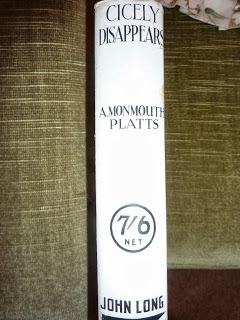
Today's Forgotten Book is one that I'm fairly confident few readers of this blog will have encountered. What's more, it was written by one of the finest novelists of the Golden Age. It's a fabulous rarity,conceivably the most sought-after of all Golden Age mysteries, and I was lucky enough to be loaned a dust jacketed copy in superb condition. I've no idea how much it was worth, but quite a bit, and you can be sure I took good care of it before returning it to its owner.And for good measure, it is a novel with a curious history. What's not to like? Well.....
The book is Cicely Disappears, and the author is A.Monmouth Platts. Now, if that name is unfamiliar to you, I should add that it's a pseudonym, composed of the names of two houses owned by Anthony Berkeley Cox, whose much better known pen-names were Anthony Berkeley and Francis Iles. Regular readers of this blog will be well aware that I'm a fan of Berkeley-Iles. He really was an interesting writer.
This particular story began life as a serialisation published by The Daily Mirror, of all newspapers,under the by-line of A.B. Cox. The Mirror ran a competition with prizes for those who guessed the solution correctly.The story was at that stage called The Wintringham Mystery, and Tony Medawar, a great researcher into the Golden Age, published a piece in CADS some time ago explaining that Agatha Christie's husband Archie was one of the runners-up. Did Agatha enter the competition under Archie's name, I wonder?
Berkeley made some changes to the story, and published it as a novel under his new pen-name a year later. So, what of the story? It's a book of legendary rarity, but I am afraid I think this is a case where obscurity is deserved. Really, the changes to the story are largely padding, and the mystery of Cicely's fate is dragged out in a way that tempts one to skip to the end. I'm so glad I have had the chance to satisfy my curiosity by reading this particular forgotten novel, but I'm afraid the final verdict is that those who are less fortunate are not really missing out. The books that appeared under the Berkeley and Iles names are infiinitely better.
Published on October 04, 2013 02:52
October 2, 2013
The Running Heroine - guest blog by Jessica Mann
The competing merits of stand-alone and series crime novels is a topic of perennial interest, and I'm delighted to say that Jessica Mann is today contributing a guest blog on this very topic.
"Off the top of your head how many crime writers can you think of whose books are all stand alone? In fact, can you think of any? Because even those who started with one-offs usually move on to re-using the same characters, as HRF Keating, did when the first Inspector Ghote followed five stand-alones. Authors can be bored by their running heroes, as Christie seemed to become with Poirot. Lindsey Davis and Val McDermid both gave themselves breaks recently , each writing a one-off novels, but then returned to their series characters, in, almost by definition, “series places”.
Other writers feature not so much series as recurring places and people. One is Michael Gilbert, of whom Martin Edwards wrote , “It is a feature of this author’s work that he regularly created fresh and engaging characters who would pop up in various novels and short stories, without any one achieving dominance.” Characters, and places: having adopted Thomas Hardy’s cathedral city of Melchester in his first book, Close Quarters, he revived that scene of crime thirty years later in The Black Seraphim.
I enjoy these surprise encounters even more than meeting reliable old favorites. It was fun when Margery Allingham’s Amanda Fitton, introduced in one of the early, more light-hearted crime novels, reappeared half a dozen books later in The Fashion In Shrouds, after which she’s a fixture. Agatha Christie’s return to Hercule Poirot in her last book, Curtain, is in a different category, as she wrote the book many years earlier and put it aside for later publication.
Minor characters reappear in my own books; and some are connected by series heroines. Professor Thea Crawford, reluctant detective in The Only Security and Captive Audience, plays a small part in subsequent novels featuring her former pupil, the archaeologist Tamara Hoyland. Both of them know Dr Fidelis Berlin, introduced in A Private Inquiry, and taking a minor role in Under A Dark Sun and a major one in The Voice From The Grave.
The heroes and heroines of crime fiction often grow up (as Margery Allingham’s Albert Campion did) even reach retirement age, like Ian Rankin’s Rebus, but they usually remain vigorous and influential, as did Ngaio Marsh’s Alleyn. Very few detective heroes grow realistically old, though Ruth Rendell’s Wexford, Peter Dickinson’s Pibble and Hercule Poirot do.
And I hope the septuagenarian Fidelis is credible in my new book, Dead Woman Walking. One of its minor characters, a young Isabel Drummond, is revived forty years after her first appearance in A Charitable End. It was my first novel – so perhaps it no longer counts as a stand-alone."
Published on October 02, 2013 09:08
September 30, 2013
The Crime Writers' Association - Diamond Jubilee
I've been a member of the Crime Writers' Association since the late 80s, and over the years my involvement with the CWA, initially through the Northern Chapter founded by Peter N. Walker, has introduced me to a great many people whom I would probably never otherwise have met. It's a great social organisation - even for those, like me, who don't regard themselves as naturally very gregarious. And the CWA also takes increasingly active steps to help members to promote their work, which is a tremendous benefit at a time when it is not only hard to get published, but a challenge to remain published.
This year sees the CWA celebrate its Diamond Jubilee - on Guy Fawkes Night to be precise. This special anniversary has seen a number of notable events, including a glittering Awards Dinner, and the publication of Deadly Pleasures, which includes stories by a number of the great and the good of crime writing (along with me - editor's perk!)
I joined the CWA committee towards the end of last year, something that pressure of the day job had never previously allowed, and I do feel that under Alison Joseph's chairmanship the organisation is going from strength to strength, despite the challenges faced by publishers and authors the world over. Membership has increased very significantly, and as a result the CWA needs to operate in a very businesslike way. The role of its hard-working director, Lucy Santos, is extremely important in this respect and in a relatively short time Lucy has made a great impression.
Like any organisation, the CWA needs to look to the future, whilst at the same time remaining true to its core values and not forgetting or under-estimating the importance of its roots. I've had on my website for quite some time a modest page about the CWA, and to mark the Diamond Jubilee, I've just written an article about the origins of the CWA. As CWA archivist, I'll also be making an announcement shortly about our plans for the Archives. There's plenty of work to be done, but also a great many good things to look forward to.
This year sees the CWA celebrate its Diamond Jubilee - on Guy Fawkes Night to be precise. This special anniversary has seen a number of notable events, including a glittering Awards Dinner, and the publication of Deadly Pleasures, which includes stories by a number of the great and the good of crime writing (along with me - editor's perk!)
I joined the CWA committee towards the end of last year, something that pressure of the day job had never previously allowed, and I do feel that under Alison Joseph's chairmanship the organisation is going from strength to strength, despite the challenges faced by publishers and authors the world over. Membership has increased very significantly, and as a result the CWA needs to operate in a very businesslike way. The role of its hard-working director, Lucy Santos, is extremely important in this respect and in a relatively short time Lucy has made a great impression.
Like any organisation, the CWA needs to look to the future, whilst at the same time remaining true to its core values and not forgetting or under-estimating the importance of its roots. I've had on my website for quite some time a modest page about the CWA, and to mark the Diamond Jubilee, I've just written an article about the origins of the CWA. As CWA archivist, I'll also be making an announcement shortly about our plans for the Archives. There's plenty of work to be done, but also a great many good things to look forward to.
Published on September 30, 2013 04:19
September 27, 2013
Forgotten Book - Born to Be Hanged
Paul McGuire is an author I'd never heard of until a Golden Age loving friend of mine urged me to read McGuire's Born to Be Hanged, and generously followed up by lending me his own copy. And I'm very glad he did, because his words of praise for this well-written and engaging novel were amply justified. It's a really good read.
McGuire was Australian, and a prominent Catholic, but his writing enjoyed considerable success in the United States. This story, however (and I think many if not all his other crime novels) is set in England - rural Dorset, to be precise, and he captures the intimate nature of life in a small town on the south coast very well indeed.
The story, narrated by a retired academic called George Collins, begins nicely: "There were many reasons, most of them excellent, for Spender's death." I felt there was a touch of Francis Iles or Richard Hull about the narrative style and the sly humour. There are plenty of witty lines, and this is a real strength of the book. The victim (found hanged by lassoo, interestingly enough) is a typical Thirties victim - a really odious chap who devotes his truncated existence to upsetting people for the fun of it. So there are plenty of suspects.
I wondered if there was an Agatha Christie style trick in store for us, but McGuire structures his story quite cunningly. There is not a great deal of action, but he camouflages this pretty well, and although the narrative depends on a single (if complicated) crime, it does not flag until the later stages, when there is an unnecessarily lengthy explanation of the backstory of one of the characters. I don't think the ending, twist and all, lived up to the promise of the excellent start, and for this reason I don't claim the book ranks with the best of Berkeley and Hull. But it is still very entertaining to read, and I am encouraged to seek out more books by Paul McGuire. He was a cut above many of his peers as a writer.
McGuire was Australian, and a prominent Catholic, but his writing enjoyed considerable success in the United States. This story, however (and I think many if not all his other crime novels) is set in England - rural Dorset, to be precise, and he captures the intimate nature of life in a small town on the south coast very well indeed.
The story, narrated by a retired academic called George Collins, begins nicely: "There were many reasons, most of them excellent, for Spender's death." I felt there was a touch of Francis Iles or Richard Hull about the narrative style and the sly humour. There are plenty of witty lines, and this is a real strength of the book. The victim (found hanged by lassoo, interestingly enough) is a typical Thirties victim - a really odious chap who devotes his truncated existence to upsetting people for the fun of it. So there are plenty of suspects.
I wondered if there was an Agatha Christie style trick in store for us, but McGuire structures his story quite cunningly. There is not a great deal of action, but he camouflages this pretty well, and although the narrative depends on a single (if complicated) crime, it does not flag until the later stages, when there is an unnecessarily lengthy explanation of the backstory of one of the characters. I don't think the ending, twist and all, lived up to the promise of the excellent start, and for this reason I don't claim the book ranks with the best of Berkeley and Hull. But it is still very entertaining to read, and I am encouraged to seek out more books by Paul McGuire. He was a cut above many of his peers as a writer.
Published on September 27, 2013 02:30
September 24, 2013
Robert Barnard - A Talent to Entertain
The response to my blog post last week-end about the death of Robert Barnard really shows how popular were both the man and his books. I'm not sure how many of you read the comments on blog posts, but among the numerous very welcome comment, I'd particularly like to highlight the little anecdote told by Bob's old friend Peter Lovesey. It really captures the man and his sense of humour perfectly.
The last time I saw Bob, he presented me with copies of his two final books, as well as a very interesting article about his writing. This prompted me to write a piece about him for Mystery Scene, and Bob's fans might like to know that I've now had it uploaded on to my website.
I also thought I'd share a memory of an occasion in Bob's company more than twenty years ago. The Northern Chapter of the CWA agreed that we would produce an anthology of our crime writing (including one or two pieces of true crime) and everybody offered to chip in. It was decided that I would edit the book - a touching demonstration of faith, given that I'd never edited a book in my life at that point.
Several of us gathered, as I remember, at Ann and Tim Cleeves' house in Whitley Bay. Those also present were Bob, Val McDermid and Chaz Brenchley, as I recall. We debated issues like the book's title, and mulled over the choice of artwork offered by the publishers (ah, those were the days!) And I recall Bob entertaining us with a very good story about his late father's battles with the taxman. He was great company, and I think it says a lot that, as a very well established author at that time, he was willing to put in time and effort to a project that was enjoyable but certainly never made us any money. The book that resulted was called Northern Blood, and Bob's contribution was an entertaining story called "A Sure-Fire Speculation". From the first paragraph, which introduces us to a member of the Young Conservatives (not an organisation Bob admired greatly, it's fair to say), you knew that you were in for some fun, and so it proved.
And thanks to the efforts of people like Bob, Val, Ann and Reg Hill, Northern Blood started me off on my strange but very satisfying career as a crime anthologist. Tweny-one anthologies later, I remain grateful to them.
The last time I saw Bob, he presented me with copies of his two final books, as well as a very interesting article about his writing. This prompted me to write a piece about him for Mystery Scene, and Bob's fans might like to know that I've now had it uploaded on to my website.
I also thought I'd share a memory of an occasion in Bob's company more than twenty years ago. The Northern Chapter of the CWA agreed that we would produce an anthology of our crime writing (including one or two pieces of true crime) and everybody offered to chip in. It was decided that I would edit the book - a touching demonstration of faith, given that I'd never edited a book in my life at that point.
Several of us gathered, as I remember, at Ann and Tim Cleeves' house in Whitley Bay. Those also present were Bob, Val McDermid and Chaz Brenchley, as I recall. We debated issues like the book's title, and mulled over the choice of artwork offered by the publishers (ah, those were the days!) And I recall Bob entertaining us with a very good story about his late father's battles with the taxman. He was great company, and I think it says a lot that, as a very well established author at that time, he was willing to put in time and effort to a project that was enjoyable but certainly never made us any money. The book that resulted was called Northern Blood, and Bob's contribution was an entertaining story called "A Sure-Fire Speculation". From the first paragraph, which introduces us to a member of the Young Conservatives (not an organisation Bob admired greatly, it's fair to say), you knew that you were in for some fun, and so it proved.
And thanks to the efforts of people like Bob, Val, Ann and Reg Hill, Northern Blood started me off on my strange but very satisfying career as a crime anthologist. Tweny-one anthologies later, I remain grateful to them.
Published on September 24, 2013 04:26
A Very British Murder - BBC Four
A Very British Murder began on BBC Four last night and offered a fascinating parallel with a storyline in one of my own novels. BBC Four is a home for informative and engaging documentaries and is one of my favourite channels - I'm currently enjoying a terrific series presented by Neil Brand on the subject of movie soundtracks. Brand is an engaging character, and so is Lucy Worsley, the presenter here. I've not come across her previously, but she proved to be a confident and charismatic performer, and a quick internet research revealed that she is a historian, curator and experienced presenter and writer.
This documentary focused on a number of notable murder cases in the nineteenth century, and my attention was immediately grabbed by a familiar scene - Grasmere. Yep, it turned out that Lucy Worsley's starting point was Thomas De Quincey's thoughts on murder as a fine art - that is, exactly the same as Daniel Kind's starting point for his book The Hell Within, which features in The Serpent Pool. In my novel, Daniel is writing a history of murder much along the lines of Lucy Worsley's, and there's a connection with the murder plot in the novel.. Spooky...
Lucy Worsley, like Daniel Kind, is an Oxford-educated academic historian who like Daniel has made a name in television, but I think it's fair to say that she performs on screen with even more gusto than Daniel would be likely to manage, joining in bloodthirsty Victorian bar songs, and co-performing a melodrama on stage. She comes over as a fun person, as Neil Brand does when he plays piano and explains the secrets of John Barry's genius. And that feeling of empathy helps strengthen the appeal of a programme of this sort..
Her accounts of the murder cases such as the Ratcliff Highway murders, the Red Barn murder, the Bermondsey Horror were sound if inevitably concise. The narrative was along the same lines as the approach of Judith Flanders in her very well-researched The Invention of Murder, so I wasn't surprised to see Judith Flanders named as a consultant when the credits rolled. All in all, an agreeable hour's viewing, with the added bonus for me of a vivid realisation of what Daniel Kind might have made of his research for his fictional masterpiece. If only he had he not become disillusioned with telly and downshifted to the Lake District....
This documentary focused on a number of notable murder cases in the nineteenth century, and my attention was immediately grabbed by a familiar scene - Grasmere. Yep, it turned out that Lucy Worsley's starting point was Thomas De Quincey's thoughts on murder as a fine art - that is, exactly the same as Daniel Kind's starting point for his book The Hell Within, which features in The Serpent Pool. In my novel, Daniel is writing a history of murder much along the lines of Lucy Worsley's, and there's a connection with the murder plot in the novel.. Spooky...
Lucy Worsley, like Daniel Kind, is an Oxford-educated academic historian who like Daniel has made a name in television, but I think it's fair to say that she performs on screen with even more gusto than Daniel would be likely to manage, joining in bloodthirsty Victorian bar songs, and co-performing a melodrama on stage. She comes over as a fun person, as Neil Brand does when he plays piano and explains the secrets of John Barry's genius. And that feeling of empathy helps strengthen the appeal of a programme of this sort..
Her accounts of the murder cases such as the Ratcliff Highway murders, the Red Barn murder, the Bermondsey Horror were sound if inevitably concise. The narrative was along the same lines as the approach of Judith Flanders in her very well-researched The Invention of Murder, so I wasn't surprised to see Judith Flanders named as a consultant when the credits rolled. All in all, an agreeable hour's viewing, with the added bonus for me of a vivid realisation of what Daniel Kind might have made of his research for his fictional masterpiece. If only he had he not become disillusioned with telly and downshifted to the Lake District....
Published on September 24, 2013 03:26
September 23, 2013
Budapest







Who is the most famous Hungarian-born crime writer? Don't all answer at once! I have to say that very few names spring to my mind, but Baroness Orczy, creator of the Old Man in the Corner (and also that rather less satisfactory character, Lady Molly of Scotland Yard) is the obvious candidate. Orczy was a very skilled writer of popular fiction,and a founder member of the Detection Club, but is much better known for her books about the Scarlet Pimpernel.
Another candidate from the past would be Balduin Groller, whom I first came across in one of Hugh Greene's four excellent anthologies showcasing the rivals of Sherlock Holmes - some of their exploits were entertainingly televised in the Sixties, and are now to be found on DVD. And there's a recent novel called Budapest Noir, but I haven't read it as yet, so can't comment.
These reflections were prompted by a short trip to Budapest, a city whose history and architecture I found very impressive. I've stayed in Britain throughout the summer, but as we were about to enter autumn, I felt like a change of scene, and I'm very glad I did. Although the visit was brief, it did give me a chance to get a good impression of the main sights, and to admire such diverse attractions as Heroes' Square, the stunning Church in the Rock, and Margaret Island, a lovely spot in the middle of the Danube with one of the most dazzling fountains I've seen anywhere in the world.
In the past couple of years, I've visited several places that were, a mere quarter of a century ago, under Communist control. It's safe to say that the locals have, in every case, embraced capitalism. You would expect this in tourist centres, of course, but even so, the people I spoke to seemed happy with the new way of life, despite a recent bumpy ride in economic terms. And members of the younger generation cannot even remember the Communist way of life. It's striking how things can change in such a relatively short time, and visiting a place which has seen such turbulence over the years is very thought-provoking for any novelist.
Mind you, I haven't as yet come up with a story idea as a result of my trip. Though it can take a while for ideas to gestate following a visit to a new location. Only now am I really getting to grips with a plot for a story set on Gran Canaria, where I spent a very enjoyable day in the sun back in March. Sometimes it works that way - other times an idea sparked by a change of scene demands to be written out immediately, before inspiration fades. That's the nature of writing, I suppose. There is no formula to it. Nor should there be.
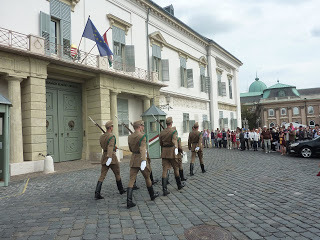



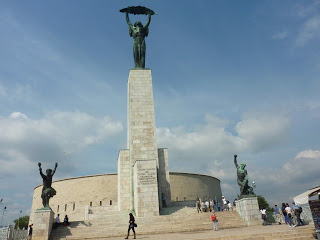

Published on September 23, 2013 03:24



